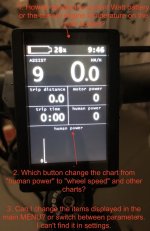thineight said:buba said:ri53hu said:Aho guys, I also started to use ALFA 10 but I can not adjust the torque sensor, I can give a more detailed explanation (or I can set it as I have 112 kg and in the hills does not stretch much.) R.
Please use a weight less than 25 kg when calibrating and it should work perfectly!
Just for my understanding, what is the range of average force that a "normal" cyclist applies on the pedals during a ride, intended as force during a, say, 15% climb or pushing a bike at 40 km/h with a 52t chainring?
I feel I'm not putting a force above 20 kg for 95% of the time, therefore I do not fully understand the need to calibrate the nonlinear segment up to the full body weight.
If we already have a sensor that can reasonably appreciate linearly 25kg, maybe buba's signal-torque coefficient is enough to calculate the human power that is accurate enough for practically all the situations..
I maybe miss some pieces in the logic, so please feel free to add more details and explaination.
Many thanks
The engineers behind the TSDZ2 tried to come up with what effective range would be sufficient enough and keep the costs down. So I think they had a goal somewhere between a max value of 30 to 50 kg for their torque sensor using the standard crank arms. With an appropriate assist level this would be sufficient enough for almost all users. So your logic is totally valid and not in any way flawed! It is simply a good observation of how they probably designed the system!
What Casainho wants to do is to increase the effective range so it can measure around the 100 kg level. This would enable a low assist level multiplier but still have the possibility to get a lot of assistance. You just push more and get more. The result would be that we can remove a couple of assist levels. Every assist level would be closer to a really nicely configured eMTB.
Mctubster replied to you with a great analysis I am also going to include here:
mctubster said:If you are in the cadence range of 60-90RPM and producing say 200W (a reasonable continuous limit for a fit recreational rider) your torque will be
Torque = 9.5488 x Power (W) / Speed (RPM)
So in this example pedal torque in the range of 32-21 Nm or based on 170mm cranks, approx 19-12kg weight (all of this averaged over 360deg)


